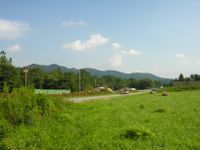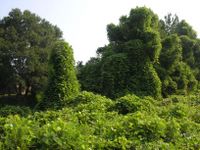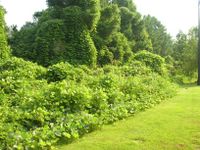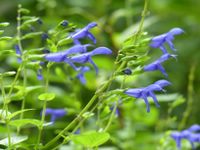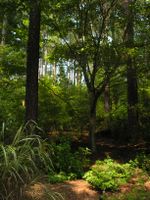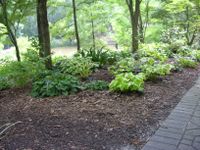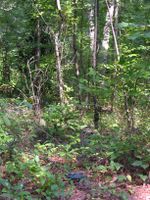Sunday, August 07, 2005
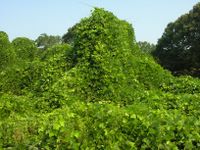
Kudzu. This is a Japanese ground cover that has become a noxious weed in the southeast. It can grow a foot a day and will completely cover tree, shrubs and other vegetation thereby smothering and killing it.
Kudzu, has been a popular food in Japan and China for thousands of years. Most of the plant can be eaten -- the tender leaves and stems can be cooked as with other Greens. However, it's the tuberous roots that offer this plant's real premium. These roots are dehydrated and pulverized, and it is this starchy kudzu powder that is used for cooking in myriad ways -- from thickening soups and sauces to Dredging foods to be deep-fried. It's high in fiber, protein and vitamins A and D.
Kudzu, Pueraria lobata (syn. P. montana, P. thunbergiana), is one of about 20 species in the genus Pueraria in the pea family Fabaceae, subfamily Faboideae. It is native to southern Japan and southeast China in eastern Asia. The name comes from Japanese kuzu (葛), meaning vine. The other species of Pueraria also occur in southeast Asia, mostly further south.
It is a climbing, woody or semi-woody, perennial vine capable of reaching heights of 20–30 m (66-98 ft) in trees, but also scrambles extensively over lower vegetation. The leaves are deciduous, alternate and compound, with a petiole (leaf stem) 10–20 cm (4–8 in) long and three broad leaflets 14–18 cm (6–7 in) long and 10 cm (4 in) broad. The leaflets may be entire or deeply 2–3 lobed, and are pubescent underneath with hairy margins.
The flowers are borne in long panicles 10–25 cm (about 4–10 in) long with about 30–80 individual blooms at nodes on the stems (see image). Each flower is about 1–1.5 cm (about 0.4–0.6 in) long, purple, highly fragrant. The flowers are copious nectar producers and are visited by many species of insects, including bees, butterflies and moths. Flowering occurs in late summer and is soon followed by production of brown, hairy, flattened, seed pods, each of which contains three to ten hard seeds.
The non-woody parts of the plant are edible. The young leaves can be used for salad or cooked as greens; the flowers battered and fried (like squash flowers); and the starchy roots can be prepared as any root vegetable.
Once established, kudzu plants grow rapidly, extending as much as 20 m (60 ft) per season at a rate of about 30 cm (12 in) per day. This vigorous vine may extend 10–30 m (30–100 ft) in length, with basal stems 1–10 cm (1–4 in) diameter. Kudzu roots are fleshy, with massive tap roots 10–20 cm (4–8 in) or more in diameter, 1–2 m (3–6 ft) or more in length, and weighing as much as 180 kg. As many as thirty stems may grow from a single root crown.
Kudzu grows well under a wide range of conditions and in most soil types. Preferred habitats are forest edges, abandoned fields, roadsides, and disturbed areas, where sunlight is abundant. Kudzu grows best where winters do not drop below –15 °C (5 °F), average summer temperatures are regularly above 27 °C (80 °F), and annual rainfall is 1000 mm (40 in) or more. In areas where winters drop below –15 °C, it will be killed to ground level, but the roots may send up new growth in the spring.
Uses
Culinary
The starchy roots are ground into a fine powder and used for varieties of Wagashi and herbal medicines. When added to water and heated, kudzu powder becomes clear and adds stickiness to the food. The name Kudzu appeared first in Kojiki and Nihonshoki as a type of vine or Kazura (葛 or 蔓) used commonly by the people who lived in Kudzu (国栖), area around present-day Yoshino, Nara prefecture. It is unclear whether the name was taken from the people or the name of the plant was applied to the people. Kudzu has been in use for over 1300 years and it is speculated that it goes back even further. In the Nara and Heian era, records had been found that they were collected and sent as a part of tax. Even today, "Yoshino Kudzu" has the best image of kudzu powder yet. Kagoshima prefecture is the largest producer of kudzu products.
Medicinal
Studies have shown [1] (http://www.med.unc.edu/alcohol/research/Overstreet/kudzu.html) that kudzu can reduce both hangovers and alcohol cravings. The mechanism for this is not yet established, but it may have to do with both alcohol metabolism and the reward circuits in the brain. Kudzu also contains a number of useful isoflavones, including daidzein (an anti-inflammatory and antimicrobial agent), daidzin (a cancer preventive) and genistein (an antileukemic agent). Kudzu is a unique source of fourth isoflavone, Puerarin. Kudzu root compounds can affect neurotransmitters (including serotonin, GABA, and glutamate) and it has shown value in treating migraine and cluster headache [2] (http://med-owl.com/clusterheadaches/tiki-index.php?page=Kudzu). In traditional Chinese medicine, kudzu was used for tinnitus, vertigo, and Wei syndrome (superficial heat close to the surface).
Kudzu as an invasive exotic
Kudzu was introduced from Japan into the United States in 1876 at the Philadelphia Centennial Exposition, where it was promoted as a forage crop and an ornamental plant. From 1935 to the early 1950s, farmers in the South were encouraged to plant kudzu to reduce soil erosion, and Franklin D. Roosevelt's Civilian Conservation Corps planted it widely for many years. Kudzu was recognized as a pest weed by the United States Department of Agriculture in 1953, and was removed from its list of permissible cover plants.
Kudzu is now common throughout most of the southeastern United States, and has been found as far north as Pennsylvania, and as far south as northern Florida. It has also been found growing (rather inexplicably) in Clackamas County, Oregon in 2000 ([3] (http://www.oda.state.or.us/information/news/2000/kudzu.html)). In all, kudzu infests 20,000 to 30,000 square kilometres of land in the United States and costs around $500 million annually in lost cropland and control costs. It cannot tolerate extremely low freezing temperatures that bring the frost line down through its entire root system; however it does require some cold weather (a solid frost or freeze annually).
Kudzu vines can make walking across the land nearly impossible, as it takes over all horizontal and vertical surfaces, both natural and manmade. Its dense growth obstructs all views and movement into the area. It kills or degrades other plants by smothering them under a solid blanket of leaves, by girdling woody stems and tree trunks, and by breaking branches or uprooting entire trees and shrubs through its weight.
The spread of kudzu in the U.S. is mainly by vegetative expansion by runners and rhizomes and by vines that root at the nodes to form new plants. Kudzu will also spread by seeds, which are contained in pods and mature in the autumn. One or two viable seeds are produced per cluster of pods. These hard-coated seeds may not germinate for several years, which can result in the re-appearance of the species years after it was thought eradicated at a site.
It is said that many common herbicides actually appear to make the plant stronger.
Control
For successful long-term control of kudzu, the extensive root system must be destroyed. Any remaining root crowns will lead to reinfestation of an area. Mechanical methods involve cutting vines just below ground level and destroying all cut material. Close mowing every month or regular heavy grazing for two growing seasons, or repeated cultivation may be effective. Cut kudzu can be fed to livestock, burned or enclosed in plastic bags and sent to a landfill. If done in the spring, cutting must be repeated as regrowth appears to exhaust the plant's stored carbohydrate reserves. Late-season cutting should be followed up with immediate application of a systemic herbicide to cut stems, to encourage transport of the herbicide into the root system. Repeated applications of several soil-active herbicides have been used effectively on large infestations in forestry situations. Efforts are being organized by the U.S. Forest Service to search for biological control agents for kudzu, and a particular fungus is currently in testing.














